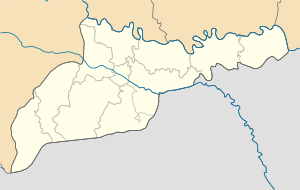Shypyntsi
Shypyntsi (Ukrainian: Шипинці; Romanian: Şipeniţ), a village in Ukraine, is located within the Kitsman Raion (district) of the Chernivtsi Oblast (province), about 530 kilometers (330 mi) driving distance southwest of Kiev, and about 30 kilometers (19 mi) northwest from the provincial capital of Chernivtsi. Shypyntsi is about 48 kilometers (30 mi) from the Ukrainian/Romanian border, about 64 kilometers (40 mi) from the Ukrainian/Moldovan border, and about 80 kilometers (50 mi) from the city of Suceava, Romania. This village is located on the left bank of the Prut River, amid rolling hills covered with farms and forests, in the region generally known as the Dniester Hills.
Shypyntsi Шипинці | |
|---|---|
 Shypyntsi Location of Shypyntsi | |
| Coordinates: 48°22′36″N 25°45′01″E | |
| Country Oblast Raion | Ukraine Chernivtsi Oblast Kitsman Raion |
| Elevation | 180 m (593 ft) |
| Population (2001) | |
| • Total | 3,160 |
| Time zone | UTC+2 |
| • Summer (DST) | UTC+3 |
| Postal code | 59341 |
| Area code(s) | +380 3736 |
To the north of the village are the ancient ruins of a Cucuteni-Trypillian culture settlement, dating back to the 5th Millennium to early 4th Millennium BC. Archaeological excavation began at this site in the late 19th century by a team of Ukrainians: J. Shombathy, R. Kindle, F. Volkov, O. Kandyba and Tatiana Sergeyevna Passek. Houses, earthenware, and ceramic shards were discovered, and in 1938 Kandyba published a collection of images from this site of beautifully decorated pottery.[1]
This settlement was part of the Neolithic Cucuteni-Trypillian culture, which lasted from 5100 to 2750 BC, and which had some of the largest communities in the world at the time. The members of this society plowed their farms, raised livestock, hunted and fished, created textiles, and developed a beautiful and highly refined style of pottery with very intricate designs. Their settlements were built in oval or circular layouts, with concentric rows of houses interconnected to form rings around the center of the community, where often a sanctuary building would be found. They left behind a large number of clay figurines, many of which are regarded as Goddess fetishes. For over 2500 years their culture flourished with no evidence left behind that would indicate they experienced warfare.[2] However, at the beginning of the Bronze Age their culture disappeared, the reasons for which are still debated, but possibly as a result of invaders coming from the Steppes to the east.[3]
The artifacts taken from the Shypyntsi ruins are kept in museums in Chernivtsi and Vienna.[1]
References
- Videiko, Mykhailo Yu. "Settlements of the Trypillian culture in Ukraine : a short guide" (PDF). The Trypillian Civilization Society. The Trypillia-USA-Project. Archived from the original (PDF) on September 5, 2008. Retrieved 15 December 2009.
- Tringham, Ruth (2005), "Weaving house life and death into places: a blueprint for a hypermedia narrative", in Bailey, Douglass W.; Whittle, Alasdair W.R.; Cummings, Vicki (eds.), (Un)settling the neolithic (PDF), Oxford: Oxbow, ISBN 1-84217-179-8, OCLC 62472378, archived from the original (PDF) on 2011-07-19
- Gimbutas, Marija Alseikaitė (1991), The civilization of the Goddess: the world of Old Europe, San Francisco: HarperSanFrancisco, ISBN 0-06-250368-5, OCLC 123210574
External links
- The Trypillia-USA-Project The Trypillian Civilization Society homepage (in English).
- The Institute of Archaeomythology The homepage for The Institute of Archaeomythology, an international organization of scholars dedicated to fostering an interdisciplinary approach to cultural research with particular emphasis on the beliefs, rituals, social structure and symbolism of ancient societies. Much of their focus covers topics that relate to the Cucuteni-Trypillian Culture (in English).
- Trypillian Culture from Ukraine A page from the UK-based group "Arattagar" about Trypillian Culture, which has many great photographs of the group's trip to the Trypillian Museum in Trypillia, Ukraine (in English).
- Трипільська культура в Україні з колекції «Платар» (Ukrainian language page about the Ukrainian Platar Collection of Trypillian Culture).
- Eneoliticul est-carpatic blog entry The Cucutenian communities in the bahlui Basin (summary), by Dr. Dumitru D. Boghian of Archaeology Department of The "Ştefan cel Mare" University of Suceava, Romania.